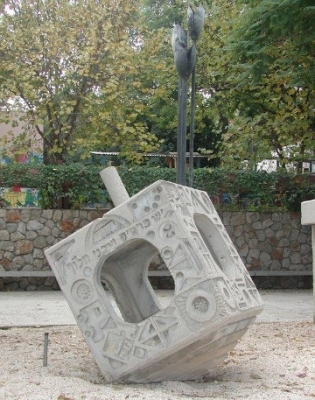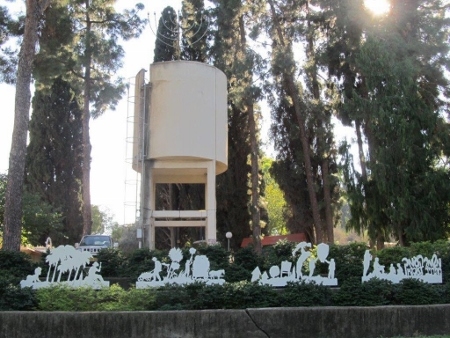Dreidel that Keeps Alive Memories
Story and photos by Lydia Aisenberg
Toddlers whoop with delight as they climb in, out and over a huge concrete dreidel strategically placed on a small incline between two kibbutz kindergartens.
As the toddlers' voices reverberate between the buildings and over the community's central lawn below, messages of another kind emanate from the boisterous children at play. For the older members of the community that play frame is a reminder of loss, pain and keeping the light of survival burning, for the dreidel is a permanent memorial to three children and a young mother-to-be who were killed in a raid by an Iraqi plane in 1948.
That fateful night the children were tucked up snugly in their beds in a children's house when the Iraqi bomber pilot dropped his deadly load in the middle of the Chanukah holiday on Kibbutz Mishmar HaEmek. The pilot was circling the Jezreel Valley in search of the British Air Force base of Ramat David – named after former British Prime Minister David Lloyd-George – situated some six kilometers from the kibbutz, and being used by the fledgling Israeli Air Force.
The children's house was the first brick building to be constructed in the kibbutz, which was founded in 1922 in the Jezreel Valley by Polish pioneers of the Hashomer Hatzair movement. The building was the center of life for a group of 9-year-olds. It was not only where they slept, showered and had their meals, but it also housed their classroom and leisure area. The building stood alongside a large wooden structure that served as the community's dining-room, which was also badly damaged in the attack. It was later replaced with a cinder block building in another area of the community, and part of the present-day complex is still in use for communal meals, served three times a day in the non-privatized veteran kibbutz.
A huge water tower on enormous stilts, all concrete and also built by the founder members, towered above the children's house on the other side of the dining-room. Atop the water tower was an electrically powered gigantic metal chanukia (menorah), each day another light adding to the previous day's celebration during the Festival of Lights.
That evening, the kibbutz was blacked out, but the members had forgotten to turn off the chanukia. Spotted by the eager Iraqi pilot and believing he had found his target, he unleashed the deadly load over the children's house, killing Yehudit, Aylit and Arieh as they slept in their beds. All three were just 9 years old, the two girls were born in the kibbutz and Arieh was a boarder from elsewhere in the country.
A young heavily pregnant woman attending a general meeting in the wood-built dining room was also killed. Severely wounded by shrapnel, Miri Reicher-Katzir was pulled from the rubble and carried across the road to the kibbutz laundry. She died as her kibbutz family and friends tried in vain to save her and her unborn child.
A large playground replaced the original wooden dining room structure, and the extensively damaged two-floor children's house was rebuilt, continuing to be home to hundreds of kibbutz-born children, until the system changed in the early 1990s and children began sleeping at home with their parents. Following the change and a period of being used as studios for kibbutz artists, the building was converted to offices for the kibbutz managers and accountants.
There had been talk at that time of demolishing the building, but an ad hoc committee of concerned members was formed and fought to have the building renovated, with a memorial plaque to be placed at the main entrance, and to ensure that the historical site would be maintained for future generations.
Two of my own five children had lived in that house in the 1970s and have many a story to tell – but that will have to wait for another time.
The memorial dreidel, a traditional game of chance and one of the best known symbols of Chanukah, sits atop an underground bomb shelter. What looks like upside down L-shaped metal pipes protruding from the ground, resembling periscopes and seemingly peeking at the sculptured spinning top, are actually the shelter's air vents. The severity of the extremely thick walls protruding above ground at the entrance to the wartime safe haven is broken by decorative art work by local kibbutz-born Ora Ron. At the time of the 1948 bombing of the children's house, Ora was asleep in her high-school dorm a few minutes' walk away. Her younger sister Elisheva slumbered in another children's house close to the one that was hit.
Thirty years after Miri and the children were killed, the father of Yehudit asked Ora, a sculptress and ceramics artisan, to create a fitting memorial to his daughter, her friends and the young mother that would never be.
"As an artist, kibbutz member and someone who had known the children personally, I gave a lot of thought to the father's request. I decided that whatever I created must connect in some way to the children, the holiday and the place itself, and that all led to the dreidel," explained Ora, who studied at the Bezalel Art Academy in the 1950s, and taught art in the kibbutz high school for many years.
"Later it was decided to have the sculpture, which I also intended to be a place for the children to play, close to the children's house where Yehudit and her friends had died, as the house is next to the water tower, with the chanukia a permanent fixture on top.
"As children in 1948, during the 10-day attack on the kibbutz, we had become accustomed to hearing the sounds of explosions, but it was frightening, especially as a lot of the kibbutz was also completely destroyed. The main building of the high school was bombed. It was an enormous, long building and that was where our dorms were. It was badly damaged in the bombing and a number of children were killed and others injured.
"While we were celebrating Chanukah, the Iraqi bomb hit the younger children's house. We, the older kids living in the high school just a few minutes' walk away, were celebrating the holiday with a quiz," explained Ora, who although now in her 80s is still heavily involved in the cultural side of kibbutz activities.
"We heard a terrible explosion, the electricity was cut off and we were in total darkness. I was really worried about my younger sister in the children's house, but then my father soon came and told me she was alright, but he also told us about the children who were killed. For many of us the trauma is something we still carry to this day," she added.
Nowadays the former children's house cum administrative offices building is literally cracking up. If one can place fingers between the cracks in the floor separating rooms from corridors, then it doesn't need too much convincing that it's time to move out. The historical building of the high school, Ora Ron's dorm of '48, sits on a high promontory overlooking the central area of the kibbutz and part of Shomria, the first regional high school in a kibbutz, which opened in 1931. The three floors and lengthy building are presently undergoing total renovation and will become the new administrative offices – with a Society for Preservation of Israel Heritage Sites blue plaque proudly affixed to an outer wall.
In April 1948 during the War of Independence, and some eight months before the bombing of the children's house at Chanukah, the central school building was badly damaged during a 10-day mortar attack on the kibbutz. High-school students blacked out windows, filled sandbags and dug trenches to protect themselves and their school. However the mortar bombs of the Arab Liberation Army, under the Syrian commander Fawzi al-Qawuji, rained down on the kibbutz from the nearby Menashe Hills, killing a number of students and badly wounding others in Shomria, as well as members of the kibbutz.
When the high-school building became dilapidated over the last decade, many meetings were held by the kibbutz members to discuss what should be the fate of the elongated 3-floor building. Eventually a decision was made to renovate the building, part of which would become offices, as well as a memorial center for the 46 members and children of the kibbutz who had died in the wars of Israel.
Once again the members will have to decide what will be the fate of the first concrete building of the kibbutz, where the three children's lives were brutally ended at the tender age of nine in December 1948.









Comments